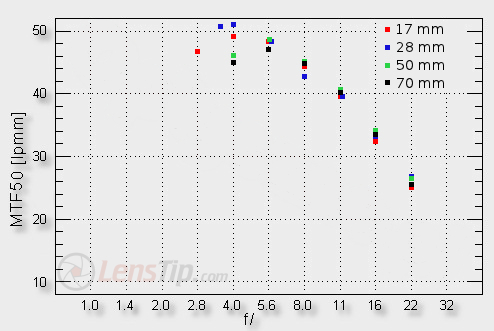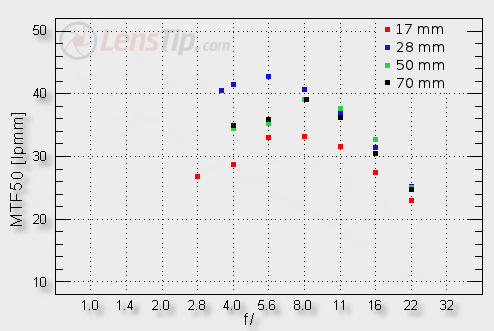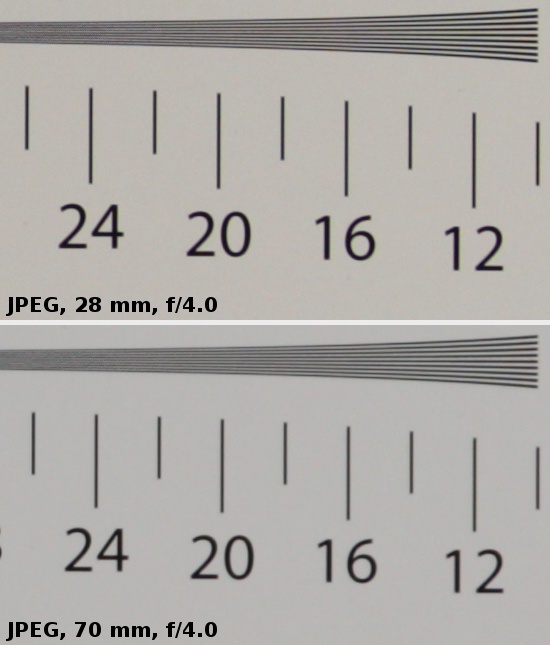Sigma C 17-70 mm f/2.8-4.0 DC Macro OS HSM
4. Image resolution
Below you can find a graph with the MTF50 values we got in the frame centre for the particular focal lengths depending on the aperture.

Please Support UsIf you enjoy our reviews and articles, and you want us to continue our work please, support our website by donating through PayPal. The funds are going to be used for paying our editorial team, renting servers, and equipping our testing studio; only that way we will be able to continue providing you interesting content for free. |
- - - - - - - - - - - - - - - - - - - - - - - - - - - - - - - - - - - - - - - - - - - - - - - -
A very even performance at different focal lengths sticks out at once. Starting from f/5.6 aperture the results at all the focal lengths are, within the margin of error, the same. More distinct differences can be observed only near the maximum relative aperture. At 17 mm and by f/2.8 we get MTFs exceeding 46 lpmm and by f/4.0 they get to 49 lpmm. These are undoubtedly very good results but, at the same time, worse than those of its predecessor which at the same focal length could reach even 52 lpmm.
The best performance the tested lens reaches at 28 mm focal length where, even at the maximum relative aperture, it gets to a sensational value of over 50 lpmm. Here the new version is a bit better than the old one – the advantage is dwindling fast after stopping down though.
The results at 50 and 70 mm focal lengths are very similar. At the maximum relative aperture the values oscillate near 45-46 lpmm so on a level we consider to be very good. After a slight stopping down the MTFs increase to about 48 lpmm. Here, for a change, there is a noticeable improvement, compared to the predecessor which, at the difficult combination of the maximum focal length and the maximum relative aperture provided images hardly useful at all.
To sum up the new lens offers an even performance at all focal lengths. Compared to its predecessor the results at 17 mm worsened a bit but they got better in the rest of the range.
Let’s check the situation on the edge of the frame now.

We really don’t like the performance at the shortest focal length where, in the whole range of apertures, you are still below the official decency level. Let’s remind here that the predecessor of the tested lens didn’t have any problems with crossing that level already after stopping down to f/4.0. In this case Sigma went really over the top improving longer focal lengths at the expense of the shorter ones.
The 28 mm focal length is the best – the images you get there are of good quality across the whole aperture range. Compared to the predecessor, there is a noticeable improvement. It would be difficult to have any reservations about 50-70 mm focal lengths. Even at the maximum relative aperture they reach near 34 lpmm so are able to provide useful images – you couldn’t say that much about the previous 17-70 mm OS model.
On the one hand we appreciate the evenness of the performance at all focal lengths. The net profit seems to be noticeable – only the shortest focal length got worse, all the others were improved. As the lower values in the frame centre at 17 mm remain still on a very good, completely acceptable level, making us more than willing to reconcile with such decrease of MTFs, the worsening on the edge of the frame we liked definitely less. The problem is so significant that it starts having an adverse effect on such usages as landscape photos where there must be an equal sharpness across the whole frame – it would be difficult to achieve it while using the new Sigma. Instead you get a useful image on the edge at the maximum focal length – a feature which is needed definitely less often. For example photographing portraits at 70 mm and by f/4.0 the averagely sharp edge of the frame is lost in the blur due to a shallow depth of field.
At the end of this chapter we present crops of our resolution testing chart, taken from JPEG files saved along with RAW files, used for the analysis above.
 |






